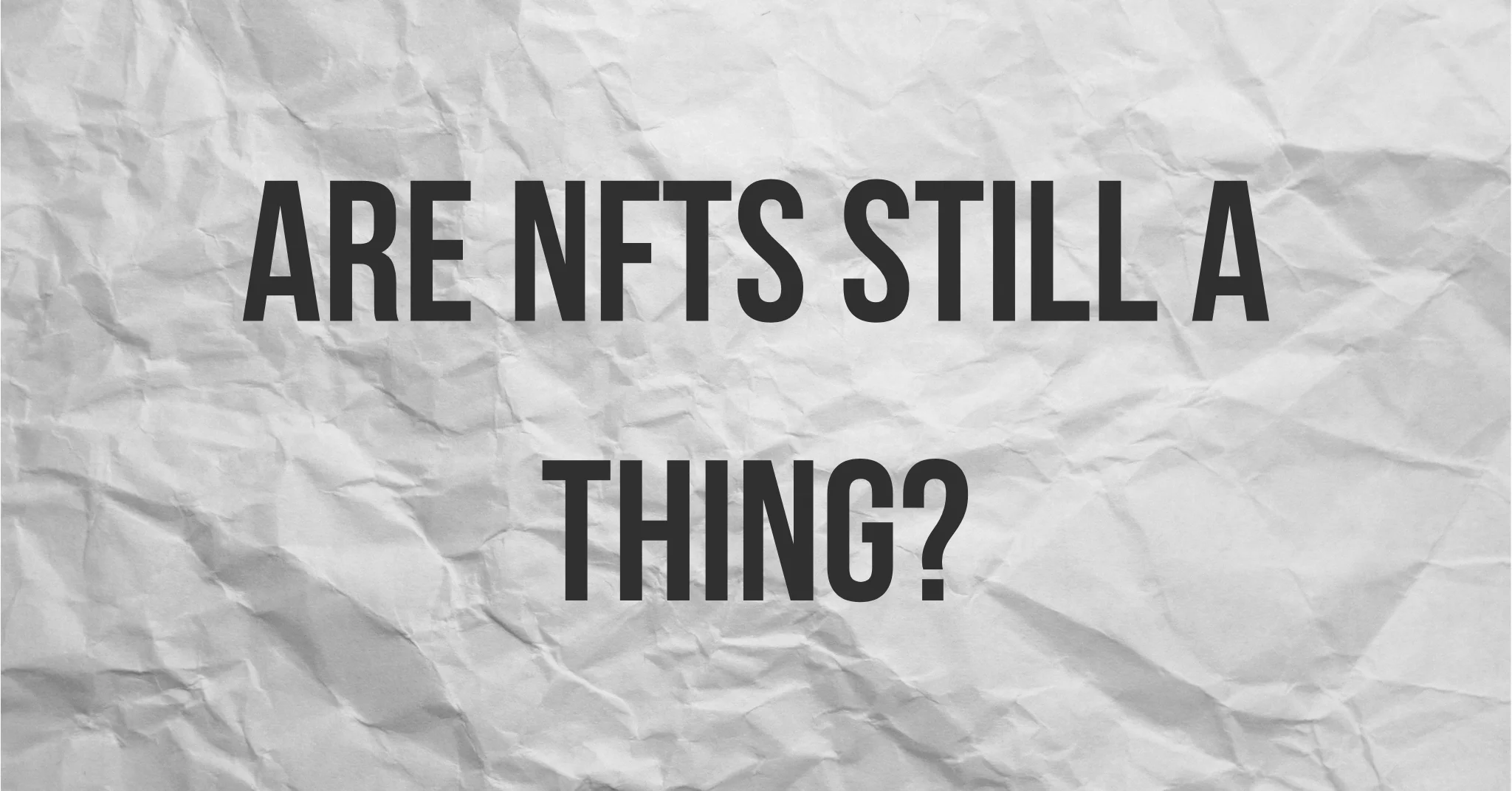
Are NFTs Still a Thing in 2025? The Current State of Digital Collectibles
The buzz around non-fungible tokens (NFTs) exploded in 2021, with jaw-dropping sales and widespread attention. But Are NFTs Still a Thing even in 2025? This is a question that neither us – nor anybody – can have an accurate answer to. Whilst their mainstream popularity has declined since 2021, the underlying technology continues to grow, with major brands continuing to experiment with NFTs and blockchain.
Fast-forward to 2025, and the NFT market tells a mixed story. NFTs no longer popped up in mainstream news daily. Prices did not stay high. Many early buyers discovered they owned tokens that nobody wanted. Still, a seed had been planted: a new way to own digital stuff existed. The question then became: Where do we go from here? Let’s explore whether are NFTs still popular and relevant in today’s digital economy.
Key Takeaways:
- Current Sentiment: Despite setbacks, NFT adoption continues, especially in niche markets.
- NFT Sales Resurgence: November 2024 sales surged to $562 million, up 57.8% from October.
- Emerging Trends: Hybrid NFTs and web3 gaming together with Metaverse drive innovation.
- NFT Market Challenges: Sales dropped 42% in June 2024, with most projects failing to maintain value.
- Future Potential: The NFT market could grow to $231.98 billion by 2030.
How NFTs Began and Their First Rise
Over the lifespan of NFTs so far, they have gone from a niche technology to a widely-known and adopted medium for digital asset ownership. Whilst we cannot confirm one way or the other if NFTs have a long-term future, we can say that blockchain technology continues to have potential and see ongoing development, and the idea of a decentralized future to the internet continues to be popular.
NFT Adoption and User Growth
Despite recent market challenges, the number of NFT users has seen a steady rise over the years.

These figures indicate a consistent upward trend, suggesting NFTs remain relevant for a growing audience, even as their uses evolve beyond just digital art.
How the NFT market changed: Are NFTs Still a Thing even in 2025?
When we look at data from 2024, we notice some major changes. Sales in June 2024 dropped by around 42%, reaching about $466 million, which might still sound big, but it showed that many had grown quiet in trading. People often talk about NFT success stories, but the truth is, that the year 2024 proved tough. The number of buyers and sellers fell. Large amounts of new collections sat untouched after their first release.
Key Stats for NFT sales:
- 98% of NFT collections created in 2024 are inactive.
- Only 0.2% of NFT drops have returned profits to investors.
- 64% of NFT launches had fewer than 10 trades in their first week.
- Ethereum blockchain accounts for $92 million in weekly sales, far outpacing other blockchains.
Why Many NFT Drops in 2024 Lost Their Value
The simple answer might be that too many people tried to sell too many NFTs too fast. With so many new drops each month, buyers got confused and bored. Most tokens looked similar. Many artists rushed to create and sell tokens without thinking about what made them valuable. After a while, the public lost interest.
Part of it could be that people got tired of collecting random digital items that had no use. Another problem involved too many new projects arriving too fast. Each month, about 3,635 new collections popped up, but few buyers wanted them. According NFTevening report – by September 2024, nearly 98% of these fresh collections showed no trading at all.
Some sellers tried harder to stand out, but the crowded market made it tough. Instead of focusing on silly hype, a few started thinking about adding real uses. NFTs might connect with games, music, or even physical goods. While 2024 brought a wave of disappointment, it also made everyone think: Should NFTs remain just images, or can they help in other ways?
New Uses for NFTs That Move Beyond Just Art
Even as attention faded from simple art collections, some tried new ideas. Instead of just a picture, what if an NFT could let you attend a virtual concert, get special music tracks, or join a private online club? Some think NFTs could become tickets, membership badges, or unique codes that let you unlock fun activities.
Gaming and Metaverse: A Doorway to NFT Growth
One area that has shown signs of hope comes from gaming and the concept some call “the metaverse.” Gamers value items they earn in their virtual worlds. They spend hours collecting rare swords, skins, or other virtual treasures. If these could be NFTs, players could truly own them. They could move them between games, share them with friends, or even sell them. This idea might convince gamers and big gaming companies to look at NFTs seriously.

For example, some large gaming studios already try NFTs as in-game items. They believe this approach might boost player loyalty. Owning your gear as an NFT means it does not belong just to the game’s server. It belongs to you. This might give players a sense of pride. It can also make trading easier. Instead of trusting a random website, you use the NFT’s proof of ownership. This might help keep trades honest.
For those wondering, If NFTs are still popular, gaming and practical utility might bring them back into the spotlight. This area might bring NFTs back into style, giving them real value. When your token serves as a pass to a fun game environment, it no longer feels empty. Gamers appreciate items they can use. This might help answer the question: “Are NFTs still a thing?” Maybe yes, if they help players find joy and show that these digital tokens can do more than just look pretty.
Hybrid NFTs: The Fusion of Digital and Real-world Assets (RWA)
Hybrid NFTs combine digital tokens with real-world assets, marking a transformative step in blockchain technology. This integration enables secure ownership, authentication, and unique applications across industries. In 2024, hybrid NFTs gained traction as a powerful tool for bridging the gap between the physical and digital worlds.
How Hybrid NFTs Work
Core Technology
- ERC404 Standard: Combines features of ERC20 and ERC721 tokens, supporting fractional ownership of both physical and digital assets.
- Secure NFC Links: Physical items embed NFC chips linked to unique digital tokens, ensuring an unbreakable connection between the two.
- Smart Contracts: Enable automated royalty payments and ownership verification, ensuring seamless management of the asset throughout its lifecycle.
Key Applications
Real Estate
- Propy’s Innovation: Propy introduced the first real estate-backed NFT sale, blending property ownership documentation with digital artwork.
- Fractional Ownership: Enables smaller investors to participate in property markets, democratizing real estate investments.
Luxury Goods
- Automotive Integration: Alfa Romeo employs NFTs as digital certificates for vehicle maintenance records, enhancing traceability.
- Fashion Authentication: High-end brands like Louis Vuitton and Prada use NFTs to authenticate luxury items, preventing counterfeiting.
Gaming and Entertainment
- Gaming Merchandise: Hybrid NFTs link in-game items with physical counterparts embedded with NFC verification.
- Market Impact: Valued at $471.90 billion in 2024, the gaming NFT market is projected to reach $942.58 billion by 2029.
The Future of NFTs: A $231.98 Billion Market?
Projections suggest the NFT market could grow at an impressive rate, potentially reaching $231.98 billion by 2030. Much of this growth will likely stem from sectors like web3 gaming and real-world asset tokenization.
Why the Optimism?
- Market Maturity: As creators focus on utility-driven projects, NFTs may find a sustainable place in digital economies.
- Diversified Applications: NFTs are being explored for loyalty programs, brand engagement, and digital certifications.
Conclusion
As we look at gaming, luxury goods, and infrastructure, many industries keep exploring NFT and blockchain use cases, seeing how this technology can reshape consumer experiences and business strategies. So, are NFTs still a thing? Investments in NFTs and blockchain technology keep rolling in. New products, tools, and services launch, and mainstream brands continue adopting, experimenting, and blending these tokens.
Government support and regulation across the globe also add a layer of stability, making it easier for NFTs and blockchains to mature. The history of NFTs includes highs and lows, and we believe these digital assets will remain a force for a long time.
FAQ: Are NFTs Still a Thing?
Are NFTs still popular in 2025?
Interest has dropped compared to earlier years. Sales fell, and many new collections attracted no buyers. Still, some new uses might bring excitement back.
Why did so many NFT collections fail?
Too many new tokens appeared with no real use. Prices dropped fast. Buyers lost interest when they saw few projects that offered lasting value.
Can NFTs still be worth something?
Yes, if they do more than look pretty. Tokens that let you join special clubs, get rare music, or interact with games might hold long-term value.
What about NFT gaming?
Some see gaming as a bright spot. If NFTs represent items gamers can truly own, this might make people excited again.
Will NFTs grow strong again?
Many experts think so, especially as creators learn from old mistakes. By 2030, the total value might climb high if NFTs bring real benefits.
How can I pick a good NFT?
Think about why you want it. Does it give you something fun or useful? Check if the creators have a good track record. If you enjoy what it offers, it might be worth owning.
Learn more about NFTs
- What is an NFT?
- What can you do with an NFT?
- How do I create an NFT?
- How do I buy an NFT?
- Why do people buy NFTs?
- Are NFTs Still a Thing? The State of Digital Collectibles
- What makes an NFT valuable?
- How do I know if an NFT is authentic?
- What was the first NFT minted?
- How to spot the best NFT to buy
- How to make money with NFTs as a beginner
- How do I convert an NFT to cash?
- How do I secure an NFT?
- Where to sell NFTs: Top NFT marketplaces
- How To Sell an NFT on the OpenSea
- Can I sell the same NFT on multiple platforms?
- Are NFTs a cryptocurrency?
- Are NFTs a good investment?
- What are the top NFT collections?
- NFT Rarity Ranking: Identify rare NFTs
- Common NFT Scams to Avoid: Protect Your NFTs
- What NFT terms do I need to know?


